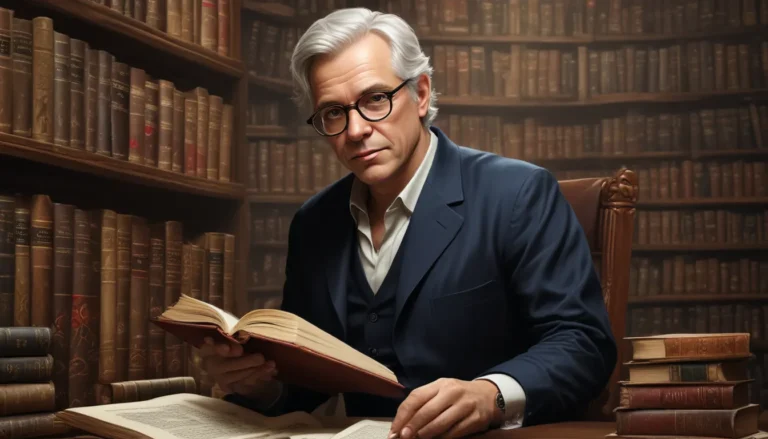The images in our articles may not match the content exactly. They are used to grab your attention, not to show the exact details in the text. The images complement the text but do not replace it.
Anastasio Somoza Debayle, a name etched in the annals of history, was a powerful figure who served as the dictator of Nicaragua from 1967 to 1979. As the last member of the Somoza dynasty to rule the country, his reign was characterized by controversy and oppression. However, beyond the surface, there are intriguing facts about this enigmatic leader that shed light on his complex character and the tumultuous era in which he held power. In this article, we will take a deep dive into the life and legacy of Anastasio Somoza Debayle, exploring sixteen astounding facts that offer a glimpse into his world. From his remarkable wealth to his fiery personality, get ready for a captivating journey into the life of one of Latin America’s most formidable dictators.
Unveiling the Enigmatic Figure: Key Takeaways
- Anastasio Somoza Debayle was a powerful and divisive leader of Nicaragua, known for his authoritarian rule, corruption, and human rights abuses.
- His legacy continues to impact Nicaraguan politics, highlighting the importance of democracy, human rights, and transparent governance in a nation’s progress.
The Rise of a Dynasty
Anastasio Somoza Debayle was born on December 5, 1925, in León, Nicaragua, into a wealthy family with political influence. His father, General Anastasio Somoza García, served as the country’s president from 1937 to 1956, laying the foundation for the Somoza dynasty.
The Military Maestro
Following in his father’s footsteps, Somoza Debayle embarked on a military career at a young age, eventually rising to lead the infamous National Guard. This position of power played a pivotal role in his ascent to authority.
A Dark Deed: The Assassination of Sandino
In a fateful turn of events in 1934, Somoza García ordered the assassination of Augusto César Sandino, a renowned Nicaraguan revolutionary. This ruthless act solidified the Somoza family’s grip on the nation and set the stage for their enduring dominance.
Presidential Reign: A Dictatorial Era
Assuming the presidency in 1967 upon the death of his father, Somoza Debayle wielded authoritarian control, stifling political dissent and bolstering his family’s supremacy during his tenure from 1967 to 1972.
A Tapestry of Corruption and Control
Under Somoza Debayle’s rule, he and his kin amassed vast riches and monopolized key sectors of Nicaragua’s economy, fostering widespread corruption and economic disparities that plagued the populace.
The National Guard’s Iron Grip
Expanding the powers of the National Guard during his presidency, Somoza Debayle transformed it into an instrument of oppression, perpetrating human rights violations and quelling all forms of opposition.
A Journalist’s Demise: The Chamorro Affair
In a significant turning point in 1978, Somoza Debayle’s administration was implicated in the assassination of Pedro Joaquín Chamorro, a vocal critic and prominent journalist. This event catalyzed public outrage and catalyzed the final stages of the Nicaraguan Revolution.
The Fall of a Dynasty: The Sandinista Revolution
Championed by the Sandinista National Liberation Front, a popular uprising led to the downfall of Somoza Debayle’s regime in 1979, marking the end of the Somoza family’s reign in Nicaragua.
Exile and Ambition: A Failed Return
Forced into exile in Paraguay post his ousting, Somoza Debayle plotted to regain power through various clandestine methods, including backing armed counter-revolutionary factions.
Tragedy Strikes: The Paraguayan Assassination
In a twist of fate in 1980, while in exile in Paraguay, Somoza Debayle met his demise at the hands of members of the FSLN, bringing a tragic end to his life while solidifying his enduring legacy in Nicaraguan politics.
The Shadow of a Despot: A Controversial Legacy
Somoza Debayle’s legacy remains a subject of contention, with divergent views on his rule. While some laud his modernization efforts and stability, critics denounce his atrocities, corruption, and autocratic rule.
Entangled in Scandal: The Iran-Contra Affair
Implicated in the Iran-Contra scandal due to his ties to the CIA and involvement in arms trafficking, Somoza Debayle’s legacy reverberated on the global stage during the turbulent 1980s.
Echoes of Revolution: Property and Power Dynamics
As the Sandinista revolution swept through Nicaragua, properties owned by the Somoza family were seized and redistributed, symbolizing a shift in wealth distribution and the end of an era.
A Nation Shaped by Dictatorship: Political Ramifications
The enduring impact of the Somoza dynasty and the revolutionary upheaval continues to shape Nicaraguan politics, grappling with the ghosts of dictatorship, corruption, and social disparities.
Navigating the Present: A Nation in Flux
Today, Nicaragua contends with multifaceted challenges stemming from political instability, human rights violations, and economic hurdles, all of which trace their roots back to the tumultuous eras of Somoza’s rule and the subsequent revolution.
Extracting Lessons: Reflections on a Dark Chapter
The sixteen captivating facts about Anastasio Somoza Debayle serve as a poignant lesson on the vitality of democracy, human rights, and the imperative of transparent and accountable governance in steering a nation’s trajectory towards progress and prosperity.
Finger on the Pulse: In Conclusion
Anastasio Somoza Debayle emerges as a polarizing figure in Nicaraguan history, leaving an indelible mark through his presidency marked by corruption, repression, and economic disparities. While interpretations of his legacy vary, one cannot deny the enduring influence he wields on Nicaragua’s present and future.
Reflecting on Somoza’s life prompts a crucial examination of the repercussions of unbridled power, the sanctity of human rights, and the pivotal role of governance in serving the populace. As we process the insights gleaned from his tumultuous rule, a sobering reminder emerges of the perils posed by unchecked authority and the indispensability of a government committed to the welfare and liberties of its citizens.
User Queries Unveiled: FAQs
-
Who was Anastasio Somoza Debayle?
Anastasio Somoza Debayle was a Nicaraguan politician and military leader who served as the President of Nicaragua from 1967 to 1979, hailing from the influential Somoza family esteemed with power. -
What impact did Somoza have on Nicaragua?
Somoza’s tenure was marked by socioeconomic disparities, authoritarian rule, and human rights violations, overshadowing some economic developments with allegations of corruption and elitism. -
How did Somoza’s reign end?
Somoza faced his downfall in the Sandinista Revolution of 1979 orchestrated by leftist rebels aiming to institute a Socialist society, a revolution that would herald the conclusion of the Somoza dynasty. -
What is the legacy of Anastasio Somoza Debayle?
Amidst divergent perspectives, Somoza’s legacy portrays a mix of stability and growth alongside tyranny and discord, encapsulating the nuances of his polarizing reign. -
How does Somoza’s reign impact Nicaragua today?
Nicaragua grapples with the enduring legacies of dictatorship and revolution, facing contemporary challenges stemming from historical imprints of corruption, inequality, and political turbulence. -
Were there any positive aspects of Somoza’s presidency?
While marred by egregious deeds, Somoza’s regime did witness certain developmental strides, although overshadowed by allegations of human rights violations and corruption. -
How did the international community respond to Somoza’s rule?
The international community’s reception to Somoza’s regime was diverse, with some nations endorsing his governance as a bulwark against communism, contrasting sharply with others condemning his violations and endorsing the Sandinistas. -
Are there any monuments or memorials dedicated to Somoza?
Nicaragua holds no public tributes to Somoza, yet remnants of his reign persist through loyalist events, encapsulating the enduring complexities of his controversial legacy.
Evolving Narratives: A Page’s Purpose
Our foundation rests upon a commitment to furnish reliable and engaging content that resonates with our diverse community of contributors. Each fact we encapsulate is a byproduct of your insights, enriching our platform with a mosaic of perspectives. Upholding unwavering standards of authenticity, every detail undergoes meticulous scrutiny by our dedicated editors. Rest assured in the veracity and vibrancy of our shared knowledge as you navigate a realm steeped in fascination and truth.
Anastasio Somoza Debayle’s saga encapsulates a poignant tableau of the hazards intertwined with unfettered dominance and the lasting ramifications of despotic regimes on nations and their populace. His legacy echoes through Nicaragua’s history, a cautionary tale underscoring the paramountcy of democracy, human rights, and accountable governance. As we ponder the reverberations of his reign, we glean invaluable insights into the intricacies of governance and the pivotal role played by influential figures in shaping the dynamics of nations worldwide.






